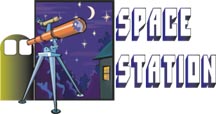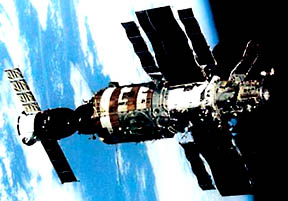|
observer |
|
|
|
|
|
OTHER LINKS |

|

|

|
|
|
|
|
A space station's life-support system, the technology that provides a comfortable interior in the space station, should include oxygen, water and food. Supplies are taken from the Earth regularly. An average human consumes 630,000 cm3 of Oxygen, about 2l of water and about 500g of dry food each day, which finally adds up to a mass of 3.4 kg.
And this life support system must also remove the carbondioxide and water that humans breathe out, and remove the fluid and solid waste they produce.
Simple space stations with open-loop systems use up all of the food, water and oxygen delivered regularly, and they discard all the waste.
Doesn't it sound scary? What if the Earth people couldn't take anything up there for a long long time? If there is an outbreak of war, or if an error occurs in the machines sent from earth, the people up there may have to starve to death.
|
|
In order to avoid such a situation and allow the crew to hang on for at least a few days, the more advanced version of the space station the closed loop space stations has been designed, today.
They can produce oxygen from carbon dioxide and also recycle the waste water into usable water. So, this reduces the supplies that must be brought from Earth to keep the crew alive.
The history
The history of space stations go back to the dawn of the 20th century. It was first proposed by the Russian scientist 'Kanstantin Tsiolkovsky'. He imagined of a large cylindrical living place that would rotate to provide artificial gravity, which allows people to walk like they normally do, on Earth, because these spacecraft would be a place where other spacecraft would stop and refuel. So, Tsiolkovsky called them stations.
The first ever space station was the Salyut 1, launched by the Soviet Union in April 1971. Salyut 1 was a simple space station with an open-loop life-support system which we explained earlier, and was launched fully assembled. It was the first in a series of nine stations that were all based on the same structure, but became increasingly sophisticated, as time passed by.
The Salyut stations which were designed consequently carried more electrical power, more computers, and some closed-loop life support systems. Salyut 6 and 7 also had two docking ports, which allowed, both, a piloted module carrying a replacement crew and an un-piloted, automated supply-delivery vehicle, to land on the stations at the same time.
These newly designed Salyut stations also demonstrated the capability of assembling larger stations while in orbit, by connecting separately launched modules together. The United States' Skylab Space Station was launched in 1973. It was launched fully assembled, and its mass (75 metric tons), was nearly four times that of Salyut 1. Skylab had open-loop life support and relied upon supplies that were already on board when it was launched. Skylab hosted three crews between 1973 and 1974 before re-entering Earth's orbit and disintegrating in 1979.
The experience that the Soviet space programme gained from Salyut was used when designing of the first permanently manned space station, Mir. The core module of Mir was launched in 1986. Mir was assembled from six modules that were launched separately, and added to the core module. Mir had several closed-loop life support systems and could support a permanent crew of three astronauts.
Mir crews were transported using the 'Soyuz' spacecraft and supplies were delivered by an unpiloted version of Soyuz, called 'Progress'.Progress could only carry three metric tons of supplies. In the 1990s the US Space Shuttle became Mir's main supply vehicle, because the ageing space station needed more supplies than ever, and Russia lacked funds, for the necessary Progress missions, to provide this.
The Space Shuttle has a much larger capacity than the Progress freighters. It provided supplies capable of keeping alive a large crew and more intensive scientific experiments.
Shuttle-Mir Missions stopped in 1998, when the United States began focusing on other projects. Russian and European astronauts continued to visit the station, using Soyuz and Progress spacecraft for transportation and supplies. Russia allowed the station to fall out of orbit and crash into the Pacific Ocean in March 2001.
We will bring you more interesting news of the mysteries of space, as and when space is available.











